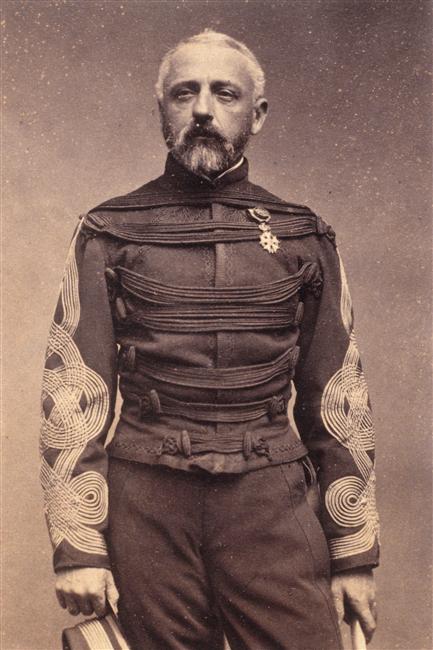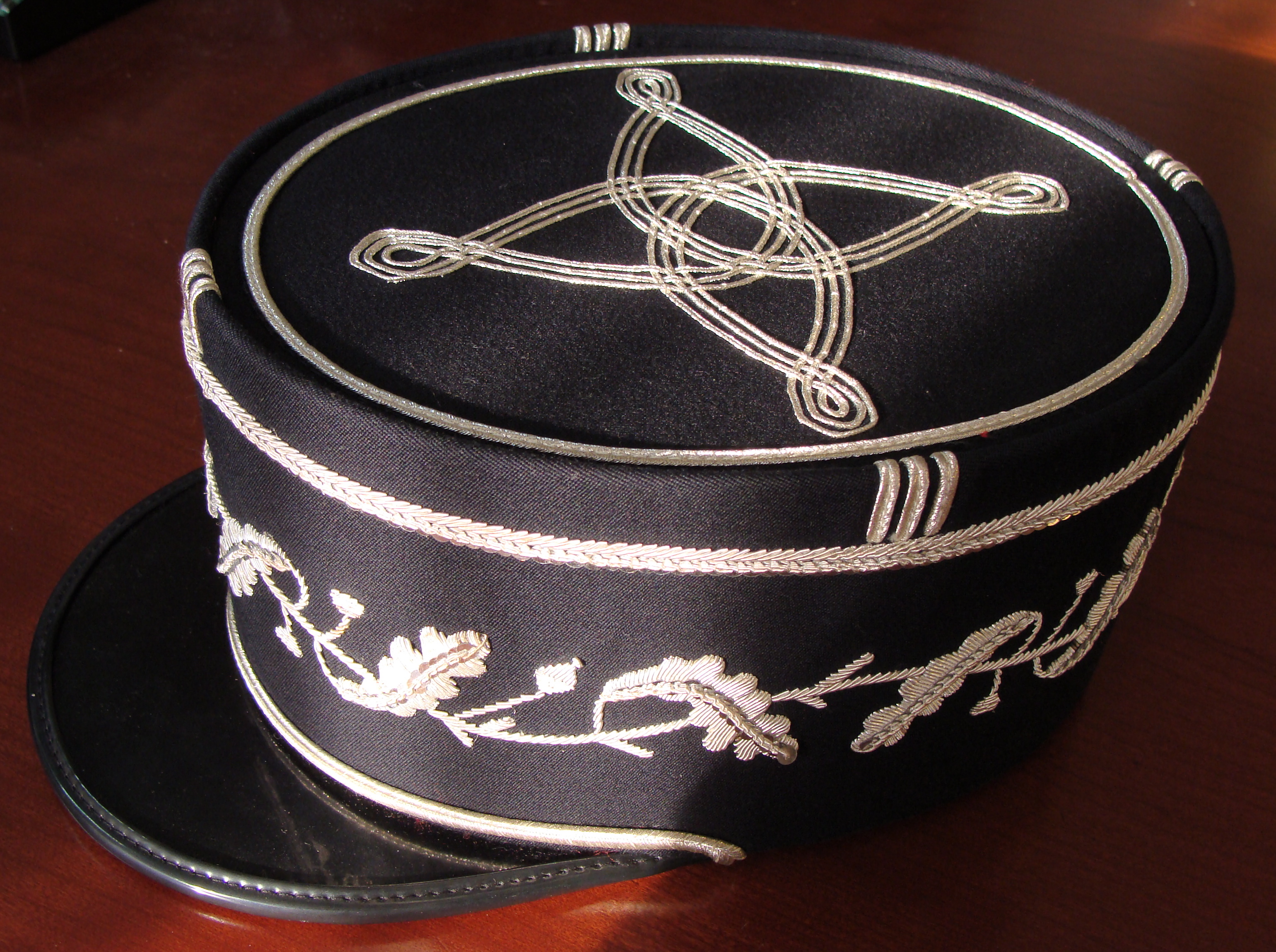Austrian Knot on:
[Wikipedia]
[Google]
[Amazon]

 An Austrian knot (or Hungarian knot), alternatively warrior's knot or , is an elaborate design of twisted cord or
An Austrian knot (or Hungarian knot), alternatively warrior's knot or , is an elaborate design of twisted cord or

lace
Lace is a delicate fabric made of yarn or thread in an open weblike pattern, made by machine or by hand. Generally, lace is divided into two main categories, needlelace and bobbin lace, although there are other types of lace, such as knitted o ...
worn as part of a dress uniform
A uniform is a variety of clothing worn by members of an organization while participating in that organization's activity. Modern uniforms are most often worn by armed forces and paramilitary organizations such as police, emergency services, ...
, usually on the lower sleeve. It is usually a distinction worn by officers
An officer is a person who has a position of authority in a hierarchical organization. The term derives from Old French ''oficier'' "officer, official" (early 14c., Modern French ''officier''), from Medieval Latin ''officiarius'' "an officer," f ...
; the major exception is the hussars, in which Austrian knots are worn by all ranks. British cadet under officers wear Austrian knots as part of their rank insignia.
History
Of Hungarian origin, the (in English "warrior's knot") evolved as an indicator of rank among hussars of the Hungarian army, and became part of the Hungarian noble attire since the 16th century. Later, as other nations added hussars to their armies, they started to use the knot as well. The reason for this was that hussar regiments were often established by Hungarian nobles and some retained the name of their founder; for example theLadislas Ignace de Bercheny
Ladislas Ignace de Bercheny ( hu, Bercsényi László) (August 3, 1689 in Eperjes, Sáros County, Kingdom of Hungary (today Prešov, Slovakia) – January 9, 1778 in Luzancy, Kingdom of France (today France) was a Hungarian-born soldier who bec ...
.
In the Austrian (later Austro-Hungarian) army of the 18th century epaulette
Epaulette (; also spelled epaulet) is a type of ornamental shoulder piece or decoration used as insignia of rank by armed forces and other organizations. Flexible metal epaulettes (usually made from brass) are referred to as ''shoulder scales' ...
s were widely perceived as foreign (due to their French origin) and thus unacceptable. In the hussar regiments ranks came to be denoted by braided gold cords on the sleeve, with the number of gold cords representing the seniority of the officer. Other branches of the Austrian Army used a system of waist-sashes and collar stars to distinguish commissioned rank.
Austrian knots soon appeared as part of the distinctive uniform of hussar regiments in the armies of other European nations but did not gain wider popularity until the last decades of the nineteenth century. First the French army, then the Dutch, Rumanian, Japanese, Turkish and several Latin American armies adopted this insignia to distinguish officer ranks. British officers of most regiments wore Austrian knots of a simplified pattern in gold braid on the cuffs of their full-dress
Full dress uniform, also known as a ceremonial dress uniform or parade dress uniform, is the most formal wear, formal type of uniforms used by military, police, firefighter, fire and other public uniformed services for official parade (military) ...
tunicsEncyclopædia Britannica, Eleventh Edition, page 585, Vol. 27 until this order of uniform ceased to be generally worn after 1914.
Along with most other elaborate and conspicuous indicators of rank, Austrian knots fell into disuse during the First World War
World War I (28 July 1914 11 November 1918), often abbreviated as WWI, was one of the deadliest global conflicts in history. Belligerents included much of Europe, the Russian Empire, the United States, and the Ottoman Empire, with fightin ...
and were not revived in everyday wear. An exception was the French Army where the kepi
The kepi ( ) is a cap with a flat circular top and a peak, or visor. In English, the term is a loanword of french: képi, itself a re-spelled version of the gsw, Käppi, a diminutive form of , meaning "cap". In Europe, this headgear is most ...
s still worn by most officers have Austrian knots in cruciform pattern on the top crown. French officers of North African regiments such as the zouaves
The Zouaves were a class of light infantry regiments of the French Army serving between 1830 and 1962 and linked to French North Africa; as well as some units of other countries modelled upon them. The zouaves were among the most decorated unit ...
and the Algerian tirailleurs
A tirailleur (), in the Napoleonic era, was a type of light infantry trained to skirmish ahead of the main columns. Later, the term "''tirailleur''" was used by the French Army as a designation for indigenous infantry recruited in the French ...
continued to wear Austrian knots in gold braid on the sleeves of their colourful full-dress uniforms until 1939. They are still worn on some parade uniforms in France, where they are called ("Hungarian knots").
United States usage
During theAmerican Civil War
The American Civil War (April 12, 1861 – May 26, 1865; also known by other names) was a civil war in the United States. It was fought between the Union ("the North") and the Confederacy ("the South"), the latter formed by states ...
, Confederate
Confederacy or confederate may refer to:
States or communities
* Confederate state or confederation, a union of sovereign groups or communities
* Confederate States of America, a confederation of secessionist American states that existed between 1 ...
officers often wore gold Austrian knots on their uniforms. More elaborate braiding indicated higher rank. This type of insignia was worn by officers of the US Army
The United States Army (USA) is the land service branch of the United States Armed Forces. It is one of the eight U.S. uniformed services, and is designated as the Army of the United States in the U.S. Constitution.Article II, section 2, cla ...
on the sleeves of the blue full-dress uniforms authorised until 1917. It is a feature of the blue mess-dress uniform adopted as optional wear for officers in 1937 and still worn for formal social or evening functions.
See also
*Frog (fastening)
(), also called () or () in China, are referred as knots, Chinese frog closures and decorative toggles in English language, is a type of ornamental braiding closure made out of cord, consisting of a button (oftentimes a Chinese button knot fo ...
– decorative fastener which originated from China and was adopted in the military clothing of Western countries.
References
{{Knots Decorative knots